CHAPTER XXI
THE 1964 WATER CRISIS
On February 6, 1964, the Cuban government ordered the water supply to the Naval Base cut off in retaliation to the arrest of 36 Cubans found fishing illegally in Florida waters. The fishermen were tried, found guilty, fined and returned to Cuba.
This was the first time since water was first received from the Yateras River in 1939 that the supply to the base was intentionally shut off by the Cuban Government. The Yateras River is located about four and one-half miles from the Northeast Gate and was the main source of the base water supply for industrial, ship and private use. The U. S. Government paid a monthly rate of about $14,000, receiving about two and one-half million gallons per day. Average consumption was about two million gallons per day with watering of lawns three times weekly.
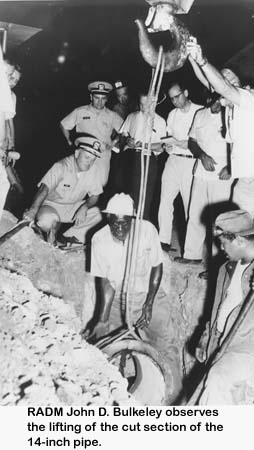 Water Conservation Starts
Water Conservation Starts
When the water cut-off occurred, about 14 million gallons of water was in base storage. Strict water conservation was put into effect immediately. Water for home use was rationed three times daily, an hour each period. Laundries, water-cooled air-conditioners, dry cleaning facilities and watering of lawns and other nonessential use of water was prohibited. The seven freshwater swimming pools were closed. Except for swimming pools, other facilities were back in operation 10 days later.
Water barges were dispatched to Ocho Rios, Jamaica, for fresh water and tankers from Norfolk commenced to supply this base with water. Two tankers, the USNS TALLULAH and SUAMICO transported water from Port Everglades, Florida on a continuing basis.
Water Pipe Lines
On February 17, 1964, Rear Admiral John D. Bulkeley, Commander Naval Base ordered that the water pipelines coming into the base be cut and a section removed to disprove the accusation made by the Cuban Government that the United States was stealing water from Cuba. A 38-inch, 300-pound section of the 14-inch pipe and a 20-inch section of the 10-inch pipe were cut and lifted from the ground and the openings sealed permanently.
When the sections of the pipes were removed, the insides were completely dry, giving definite evidence that no water had passed through the pipes since February 6. Fourteen U. S. newsmen on the base at the time witnessed the event and recorded the proceedings for the world to see.
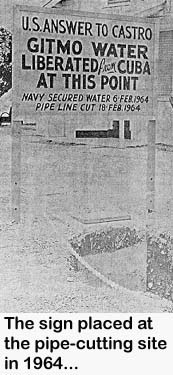
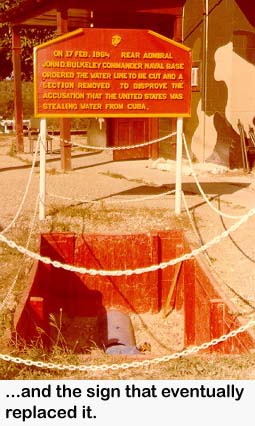 A unique sign was erected at the site of the pipe cutting which read: "U. S. ANSWER TO CASTRO ... GITMO WATER LIBERATED FROM CUBA AT THIS POINT."
A unique sign was erected at the site of the pipe cutting which read: "U. S. ANSWER TO CASTRO ... GITMO WATER LIBERATED FROM CUBA AT THIS POINT."
Water Problem Studied
The need for Guantanamo Bay's own water source had been long recognized. However, with water being furnished by the Cuban Government from the Yateras River since 1939, no urgency was placed on such a project. From time to time engineers had drilled for water at random locations on the base but the results were poor and the water was brackish and unsuitable for human consumption.
On February 8, 1964, two days after the water cut-off, the Guantanamo Bay Survey Team, headed by Rear Admiral John L. Chew, Office of the Joint Chiefs of Staff, arrived to study the water problem.
Cubans Dismissed
During the water crisis President Lyndon B. Johnson decreed that Guantanamo Bay would become as self- sufficient as possible. This included dismissal Of Cuban employees and building a desalting plant. On February 12, 1964, the first Cuban employees were dismissed and escorted off the base to conform with Presidential order. About 250 were affected in this first group and more than 2,000 were subsequently dismissed. To supplement this loss of manpower, additional Navy personnel were ordered to the base and 700 male Jamaicans were hired.
Water Plant Arrives
In mid-February 1964, the desalting plant at Point Loma, Calif., was obtained from the Department of Interior. Dismantling commenced on February 26, under the direction of the Bureau of Yards and Docks, Washington, D. C.
The SS President Grant transported the entire Point Loma plant to Guantanamo Bay, arriving'here April 15 with 600 tons of equipment.
On March 5, 1964, Secretary of the Navy Paul H. Nitze visited the Naval Base to view the defensive posture and conditions since the water cut-off. Prior to the Secretary's visit, the Chief of Naval Personnel announced in Washington, D.C. on February 13, 1964, that no additional dependents would be permitted to travel with their sponsors to Guantanamo Bay due to changing the base into a garrison force. Dependents of military and civilian personnel on board at the time of the phase-out announcement could remain until the sponsor's tour was completed.
Construction Starts
Construction of the new water plant commenced on April 1, 1964 when Rear Admiral John D. Bulkeley, Commander Naval Base, with representatives of the Westinghouse Corporation and the Burns and Roe Construction Company, broke ground for the new 10-million dollar plant. Over 180 men were employed in the construction of the plant, including civilians from the states and military personnel working as part-time laborers on their own time. Westinghouse Corporation was prime contractor for the water plant with the Burns and Roe Construction Company Western Hemisphere of New York as subcontractor.
First Water Produced
The first fresh water produced by the plant was at 3 a.m. on July 26, 1964 and four days later on July 30, 1964 the plant was formally dedicated by Mrs. John D. Bulkeley who turned a special valve which started the first flow of water from the huge plant. This first phase of a three-phase system produced 750,000 gallons of fresh water per day.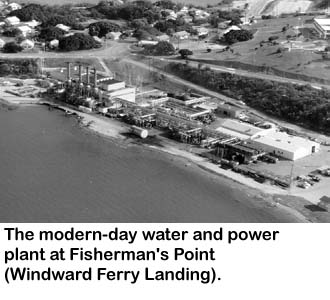
It was a happy day in Guantanamo Bay on July 27, 1964 especially for the children. The swimming pools were reopened after being closed for more than five months. The uniform of the day was changed from dungarees to whites and routine watering of lawns and shrubbery was once again undertaken on a very limited basis.
Self-Sufficiency Nears
The USNS SUAMICO terrninated its weekly trip from Port Everglades, Florida, to Guantanamo Bay on August 10, 1964, after transporting 125 million gallons of fresh water. The USNS TALLULAH continued to bring water from Port Everglades to supplement the water supply.
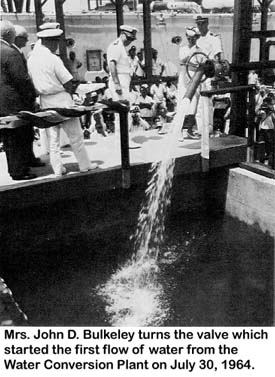 The following message was released to the Commander-in-Chief, U.S. Atlantic Fleet on September 9, 1964 from the Office of the Base Commander, Guantanamo Bay:
The following message was released to the Commander-in-Chief, U.S. Atlantic Fleet on September 9, 1964 from the Office of the Base Commander, Guantanamo Bay:
"The second saltwater conversion plant went into operation on September 7, 1964 and is now pumping about 600,000 gallons of fresh water into the base water system."
Several days after the second unit of the water conversion plant became operational the USNS TALLULAH terminated its trip to Guantanamo Bay. She arrived on September 19, 1964 with her last load of water after making 39 trips and carrying 168 million gallons of firesh water to Guantanamo Bay.
Then on December 6, 1964, the following message was released to the Commander-in-Chief U.S. Atlantic Fleet:
"Military and civilian personnel on this base saw the reality of a long-cherished dream today when RADM John D. Bulkeley, Base Commander, turned the spigot that let fresh water flow from the third and final saltwater conversion unit just completed.
"The commissioning ceremony marked Guantanamo Bay's complete self-sufficiency In water supply with the capability of producing 2.25 million gallons of fresh water from the Sea each day.
"Construction of the ten-million dollar project started April 1, 1964 and was completed in record time as civilian and military personnel worked around the clock to accomplish this outstanding engineering feat.
"The eyes of the world focused on Guantanamo Bay February 6, 1964, when the Cuban government abruptly cut off the base's water supply. For years its two-million gallon daily source had been the Yateras River four miles from the base inside Cuba.
"With the immediate curtailment of water usage except for absolutely essential purposes personnel of the base relied upon a large storage capacity, combined with water shipments from Jamaica, until the USNS tankers TALLULAH and SUAMICO commenced water-shuttle service from Port Everglades, Fla. The two ships -million gallons of delivered 293 water while the plant was being constructed.
"The first conversion unit arrived here from Point Loma, Calif., where it had been dismantled from an operational status. It was reassembled and producing 750,000 gallons daily by late July. The second unit, dubbed Gitmo No. 1, commenced producing an additional 750,000 gallons on September 7. The final phase known as Gitmo No. 2 completes the trio of conversion units which permanently solve water problems here.
"Normal daily consumption for home and industrial use has been held to about 1.5 millon gallons. However, it is now expected that restrictions such as watering of shrubs and lawns will be relaxed in the near future.
"In addition to the water conversion system now completely operational there will be two turbine generators capable of producing 15,000 kilowatts supplying electrical power to the base. These modern units will replace 17 antiquated diesel generators now in use when they become operational in a few weeks. This will result in an abundance of electrical power at a considerable saving of money and manpower."
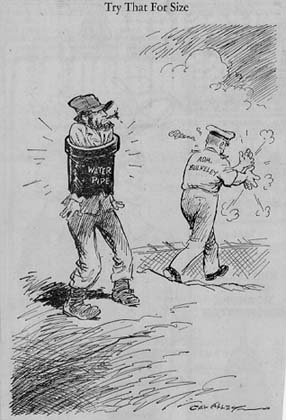 Thus ended one of the most historic moments in the annals of this base. Water which had been long sought for within the base perimeter is now in abundant supply from an inexhaustible source- the sea. It must be noted that the cooperation of military and civilians in all facets of constructing months was superb and most gratithe water plant in just eight months was superb and most gratifying. The combined efforts of both working in unity was a major factor in accomplishing this goal.
Thus ended one of the most historic moments in the annals of this base. Water which had been long sought for within the base perimeter is now in abundant supply from an inexhaustible source- the sea. It must be noted that the cooperation of military and civilians in all facets of constructing months was superb and most gratithe water plant in just eight months was superb and most gratifying. The combined efforts of both working in unity was a major factor in accomplishing this goal.
Go to Chapter Twenty-two